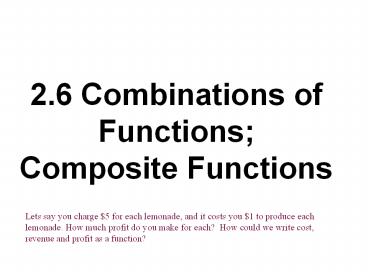2.6 Combinations of Functions; Composite Functions - PowerPoint PPT Presentation
1 / 12
Title:
2.6 Combinations of Functions; Composite Functions
Description:
... lemonade, and it costs you $1 to produce each lemonade. ... How much profit do you make for each? How could we write cost, revenue and profit as a function? ... – PowerPoint PPT presentation
Number of Views:65
Avg rating:3.0/5.0
Title: 2.6 Combinations of Functions; Composite Functions
1
2.6 Combinations of Functions Composite
Functions
Lets say you charge 5 for each lemonade, and it
costs you 1 to produce each lemonade. How much
profit do you make for each? How could we write
cost, revenue and profit as a function?
2
The Sum of Functions
- Let f and g be two functions. The sum f g is
the function defined by - (f g)(x) f(x) g(x)
- The domain of f g is the set of all real
numbers that are common (intersection) to the
domain of f and the domain of g.
3
Definitions Sum, Difference, Product, and
Quotient of Functions
- Let f and g be two functions. The sum of f g,
the difference f g, the product fg, and the
quotient f /g are functions whose domains are the
set of all real numbers common (intersection) to
the domains of f and g, defined as follows - Sum (f g)(x) f (x)g(x)
- Difference (f g)(x) f (x) g(x)
- Product (f g)(x) f (x) g(x)
- Quotient
- provided g(x) does not equal 0
4
Example
- Let f(x) 2x1 and g(x) x2-2. Find f g, f -
g, fg, and f/g. Which, if any of these, would
have domains other than all reals? - Solution
- fg (2x1) (x2-2)
- x22x-1
- f-g (2x1) - (x2-2)
- -x22x3
- fg (2x1)(x2-2)
- 2x3x2-4x-2
- x
5
REVIEW Given f(x) 2x 4 and g(x) x1, find
f(3) f(a) f(a1) f(x1) or? In general
6
Lets say you date each candidate three times
before you make a decision about them. If each
of your friends sets you up with 5 people, how
many dates will you go on? How can we write each
of these as a function? Number of dates, where x
represents one possible candidate D(x)
Number of possible candidates where x
represents one friend C(x) Number of total
possible outings given the number of friends, x,
you have F(x)
7
What we find is that the number of outings is a
function of the number of friends we have, or
F(x) D(C(x)), we can write this more elegantly
as pronounced,
D of C of x.
We can apply this concept to functions described
in any way, for EXAMPLE if We can find (Make
observations.)
8
The Composition of Functions
- The composition of the function f with g is
denoted by f o g and is defined by the equation - (f o g)(x) f (g(x)).
- The domain of the composite function f o g is the
set of all x such that - x is in the domain of g and
- g(x) is in the domain of f.
9
Text Example
Given f (x) 3x 4 and g(x) x2 6, find
a. (f o g)(x) b. (g o f)(x) c. (g o
f)(-2)
Solution a. We begin with (f o g)(x), the
composition of f with g. Because (f o g)(x) means
f (g(x)), we must replace each occurrence of x in
the equation for f by g(x).
Thus, (f o g)(x) 3x2 14.
10
Ex Cont Given f (x) 3x 4 and g(x) x2
6, find b. (g o f)(x)
Solution b. Next, we find (g o f )(x), the
composition of g with f. Because (g o f )(x)
means g(f (x)), we must replace each occurrence
of x in the equation for g by f (x).
Thus, (g o f )(x)
. Notice that (f o g)(x) _______ (g o f )(x).
11
Ex Cont Given f (x) 3x 4 and g(x) x2
6, find c. (g o f)(-2)
- Solution
- c.
12
Examples
- P 266 45 (f/g domain only)
- 66 (find fog domain)
- 78 (opt, but key) find fg so h(x)(fog)(x)
- 82 90
Do your homework (and then some)!































